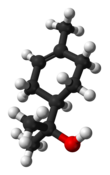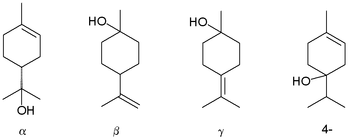Terpineolis any of fourisomericmonoterpenoids.Terpenoids are terpene that are modified by the addition of afunctional group,in this case, analcohol.Terpineols have been isolated from a variety of sources such ascardamom,cajuput oil,pine oil,andpetitgrainoil.[2]Fourisomersexist: α-, β-, γ-terpineol, andterpinen-4-ol.β- and γ-terpineol differ only by the location of thedouble bond.Terpineol is usually a mixture of these isomers with α-terpineol as the major constituent.
| |||
| Names | |||
|---|---|---|---|
| IUPAC names
p-Menth-1-en-8-ol
2-(4-Methylcyclohex-3-en-1-yl)propan-2-ol | |||
| Other names
2-(4-Methyl-1-cyclohex-3-enyl)propan-2-ol
alpha-terpineol α-terpineol α,α,4-Trimethylcyclohex-3-ene-1-methanol Terpene alcohol | |||
| Identifiers | |||
3D model (JSmol)
|
|||
| 2325137 | |||
| ChEBI | |||
| ChEMBL | |||
| ChemSpider | |||
| EC Number |
| ||
| KEGG | |||
PubChemCID
|
|||
| UNII | |||
CompTox Dashboard(EPA)
|
|||
| |||
| |||
| Properties | |||
| C10H18O | |||
| Molar mass | 154.253g·mol−1 | ||
| Appearance | Colorless liquid[1] | ||
| Density | 0.93g/cm3[1] | ||
| Melting point | −35.9 to −28.2 °C (−32.6 to −18.8 °F; 237.2 to 245.0 K)[1](mixture of isomers) | ||
| Boiling point | 214–217 °C (417–423 °F; 487–490 K)[1](mixture of isomers) | ||
| 2.42g/L[1] | |||
| −111.9·10−6cm3/mol | |||
| Hazards | |||
| NFPA 704(fire diamond) | |||
| Flash point | 88 °C (190 °F; 361 K)[1] | ||
| Safety data sheet(SDS) | External MSDS | ||
Except where otherwise noted, data are given for materials in theirstandard state(at 25 °C [77 °F], 100 kPa).
| |||
Terpineol has a pleasant odor similar to lilac and is a common ingredient in perfumes, cosmetics, and flavors. α-Terpineol is one of the two most abundantaromaconstituents oflapsang souchongtea; the α-terpineol originates in the pine smoke used to dry the tea.[3](+)-α-terpineol is a chemical constituent ofskullcap.
Synthesis and biosynthesis
editAlthough it is naturally occurring, terpineol is commonly manufactured fromalpha-pinene,which is hydrated in the presence of sulfuric acid.[4]
An alternative route starts fromlimonene:[5]
Limonene reacts withtrifluoroacetic acidin aMarkovnikov additionto a trifluoroacetate intermediate, which is easily hydrolyzed withsodium hydroxideto α-terpineol with 7% selectivity. Side-products are β-terpineol in a mixture of thecisisomer, thetransisomer,and 4-terpineol.
The biosynthesis of α-terpineol proceeds from geranyl pyrophosphate, which releases pyrophosphate to give theterpinyl cation.This carbocation is the precursor to many terpenes and terpenoids. Its hydrolysis gives terpineol.
Biosynthetic conversion ofgeranyl pyrophosphateto the terpenesα-pineneandβ-pinene(right) and to α-terpineol (bottom left).[6]
References
edit- ^abcdefRecordin theGESTIS Substance Databaseof theInstitute for Occupational Safety and Health
- ^Merck Index,11th Edition,9103
- ^Shan-Shan Yao; Wen-Fei Guo; Yi Lu; Yuan-Xun Jiang (2005)."Flavor Characteristics of Lapsang Souchong and Smoked Lapsang Souchong, a Special Chinese Black Tea with Pine Smoking Process".Journal of Agricultural and Food Chemistry.53(22): 8688–93.doi:10.1021/jf058059i.PMID16248572.
- ^Gscheidmeier, Manfred; Fleig, Helmut (June 15, 2000). "Turpentines, 16. Pine Oil".Ullmann's Encyclopedia of Industrial Chemistry.Weinheim: Wiley-VCH.doi:10.1002/14356007.a27_267.ISBN978-3527306732.
- ^Yuasa, Yoshifumi; Yuasa, Yoko (2006). "A Practical Synthesis ofd-α-Terpineol via Markovnikov Addition ofd-limonene Using Trifluoroacetic Acid ".Organic Process Research & Development.10(6): 1231–1232.doi:10.1021/op068012d.
- ^Davis, Edward M.; Croteau, Rodney (2000). "Cyclization enzymes in the biosynthesis of monoterpenes, sesquiterpenes, and diterpenes".Biosynthesis.Vol. 209. pp. 53–95.doi:10.1007/3-540-48146-X_2.ISBN978-3-540-66573-1.
{{cite book}}:|journal=ignored (help)
External links
edit- MSDS for alpha-terpineol
- Media related toTerpineolsat Wikimedia Commons



